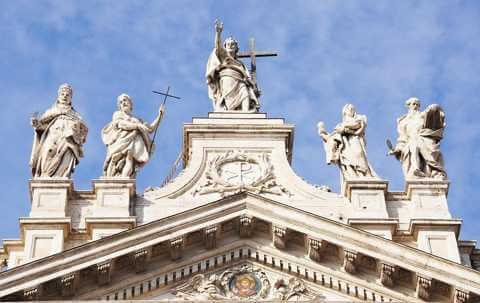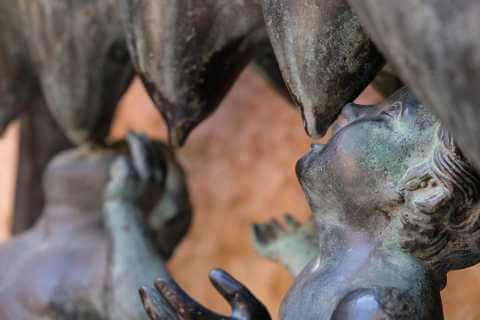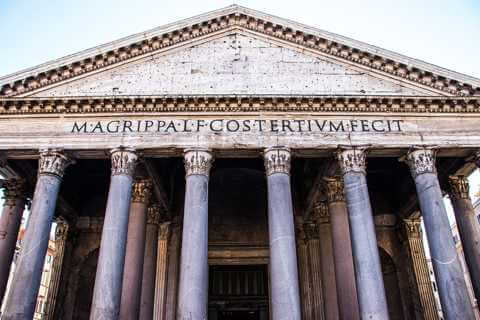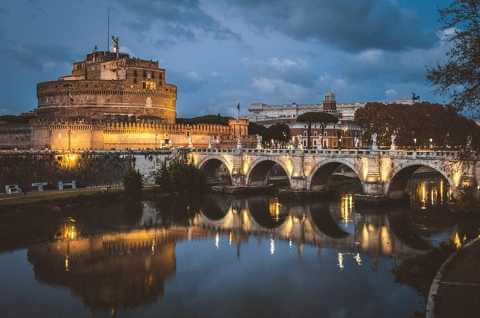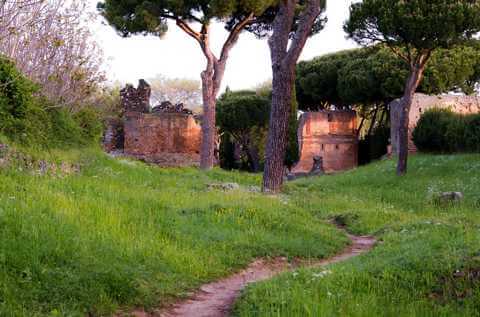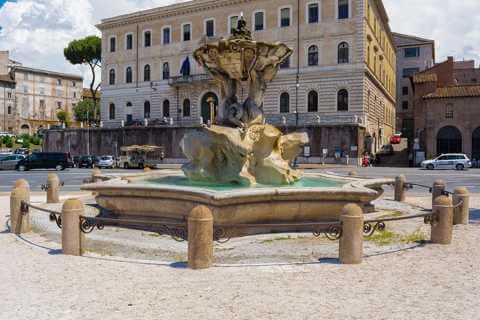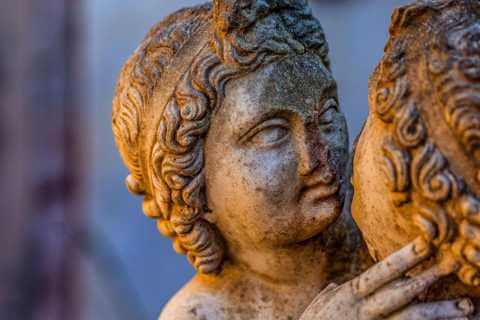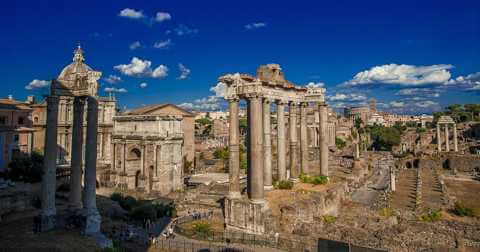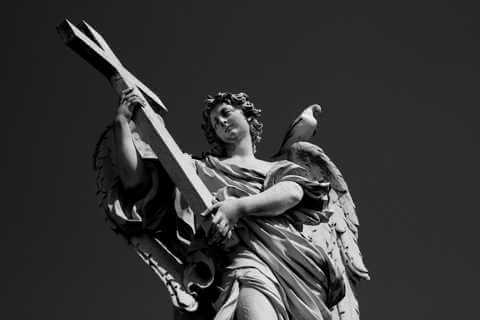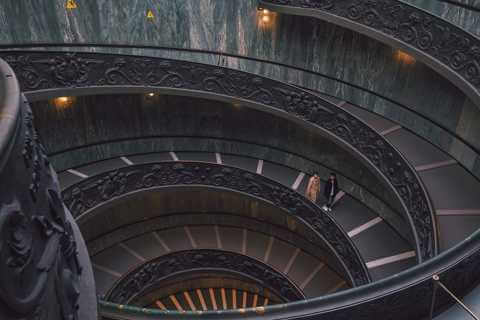History of Rome - Legends
Romulus and Remus
(There are several writers who have told the story of the twins)
Near the banks of the Tiber, in a poor hut, lived an old shepherd and his wife: Fà ustolo and Laurence. One evening Fà ustolo sat wearily at the door of the hut while Laurence prepared the meagre evening meal. Suddenly, a rustling sound was heard from the woods, and over there, towards the river, a dark shadow slid down to the shore...
Faùstolo thought of going to see what had happened, told his wife to wait for him and cautiously advanced towards the bank of the Tiber. Due to the recent rains, the river was flooded in the fields and the ground was strewn with large pools of water. In one of those puddles, at the foot of a tree, Fà ustolo saw a huge she-wolf lying on its side and two children feeding on its milk. He thought he was dreaming. He slowly withdrew and returned to the hut where he started telling his incredulous wife about the she-wolf suckling the twins, then took her by the arm and dragged her out to the river. Shortly afterwards, the two little foundlings rested in the warmth of Fà ustolo and Laurenzia's hut where they soon grew up and in a few years became two strong boys, a little wild but good. Fà ustolo had named them Romulus and Remus; and they respected him like a father, every day they went further away from the hut, in search of new adventures...
This is the story of the writer Gustavo Brigante Colonna. Legend has it, however, that once they grew up,Romulus and Remus knew their history, then they returned to Albalonga punished the cruel Amulius and freed the grandfather Numitore . Having obtained permission from him, they left Albalonga and went to the banks of the Tiber, where they had grown up, to found a new city. But which of the two would give it its name?
They decided to observe the flight of birds: whoever saw the most birds would give the city its name. Fortune favoured Romolo who took a plough and, on the Palatine Hill he drew a furrow to mark the city walls, which he called Rome . It was the day 21 April, 753 years before Jesus Christ was born. The birth of the new city unfortunately marked the end of Remus' life. It had been decreed that no one, under any circumstances, could pass beyond the furrow without the permission of the chief. But Remus, envious, or else in jest, leapt over it and, laughing, exclaimed: - Look how easy it is! - Romulus, filled with rage, hurled himself at Remus and, taking up his sword, killed him, exclaiming that anyone who offended the name of Rome must die. Romulus, left alone, ruled the city wisely, then one day, during a thunderstorm, he disappeared, abducted into the sky by the god Mars.
The Rape of the Sabine Women
Once the city was created, however, there was the problem of populating it: Romulus gathered shepherds from the surrounding areas, but lacked women. How to do this? He then thought of organising a feast, to which he invited the shepherds. Sabini with wives and daughters. While the feast was taking place amidst singing and dancing, at an agreed signal, the young Romans kidnapped the Sabine women and, armed with daggers, put the men to flight. The men returned a short time later, led by Titus Tatius, king of the Sabine tribe of the Curites, with the intention of freeing their women and taking revenge for the insult they had received. A young girl, Tarpea, opened the city gates for them: but she immediately paid for her gesture with an atrocious death, as she was crushed by the Romans' shields. Future generations would later give her name to the Tarpeian cliff, from which it became customary to throw the condemned to death. Having penetrated Rome, the Sabines launched themselves against the enemy warriors; but as soon as the battle began, the women intervened to obtain an armistice: in fact, many young girls had already become attached to the Roman spouses and could not tolerate the sight of that bloody battle in which their fathers and husbands were involved. The affair thus had a peaceful conclusion: Romulus and Titus Tatius reigned jointly over the city : Sabini e Romans merged into one people. From the name of Titus Tatius' tribe, the Curites, the Romans then derived the appellation of Quiriti.
Enea
About three thousand years ago, some ships, which had long been sailing the seas in search of a landing place, came in sight of an unknown land. These men were the only ones who had managed to escape from the terrible fire with which, after a long war, their city had been destroyed. They looked sad and tired, for years they had had to wander the seas in vain in search of a bit of rest and peace... And now before them lay a land that looked serene and welcoming. They came to a place where there was a majestic river that burst into the sea, mixing its tumultuous yellow waters with the blue waves. So when the chief gave the order, it was with true enthusiasm that they set out..... The men who were finally able to touch land were the Trojansand had landed in Lazio, on the banks of the river Tiber led by the valiant warrior Enea . He, whileTroy collapsed under the furious assault of the Greeks he had managed to rescue his father and his little son. But the father had died on the long journey; only his little son Ascanius remained.
The life and exploits of Enea are wonderfully narrated in the poem Aeneid written by the great poetVirgil Here we report only in part what are the most important episodes to proceed in the story of the foundation of Rome. Already at that time, Latium was populated by various populations: the Etruscans, the Volscians, the Sabines, the Equi, the Rùtuli and the Ausoni. The most important population, settled in a group of organised cities in the flat territory along the banks of the Tiber, were the Latins. The Trojans immediately came into contact with this people and their king, the wise Latins. He welcomed them with kindness, gave them hospitality and, some time later, offered Aeneas his own daughter Lavinia in marriage, who had already been betrothed to Turno, king of the Rútuli, who unleashed a war to avenge the offence he had received. It was a fierce war, which ended in a long duel between Aeneas and Turno, until the latter was killed. A long period of peace followed, during which Aeneas founded a city, Lavinium, in honour of his bride. Aeneas's son Ascanius, who had grown up, in turn founded the city of Albalonga. Many and many years after the death of Ascanius, the good Numitore. He had, however, a very wicked and envious brother named Amulius, who wanted to rule. To achieve his goal, he had Numitore imprisoned and forced Rea Silvia, his daughter, to become a priestess. Amulius could now consider himself safe and secure. For many years, he alone would be king. Shortly afterwards, however, the god Mars sent two twins, Romulus and Remus, to Rhea Silvia. Amulius, enraged, ordered them to be killed immediately. But he was destined to receive just punishment! The servant, entrusted with the cruel task, did not have the courage to commit such a serious crime: instead, he placed the two little brothers in a wicker basket and abandoned them in the waters of the Tiber, hoping that someone would save them. And salvation was not long in coming...

